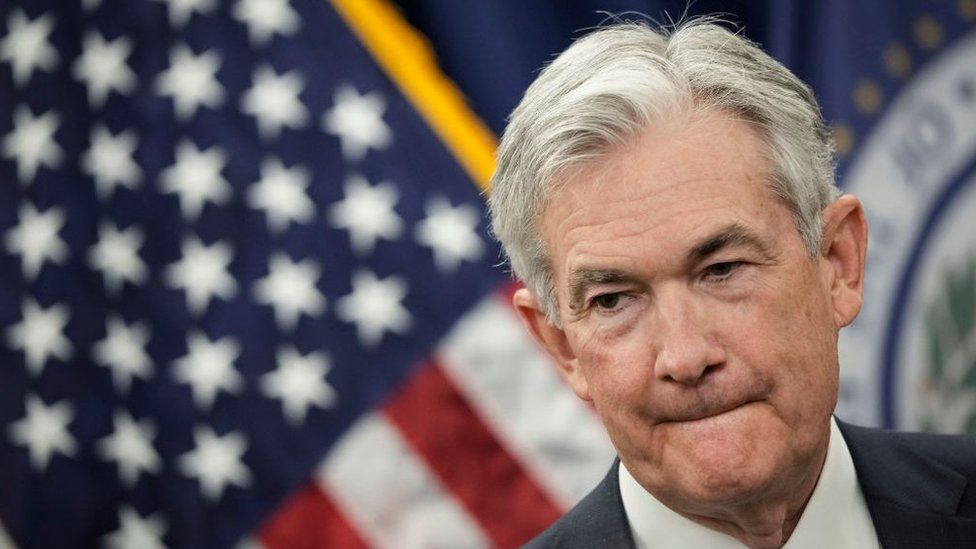
The US central bank has announced its biggest interest rate rise in nearly 30 years as it ramps up its fight to rein in soaring consumer prices.
The Federal Reserve said it would increase its benchmark rate by three quarters of a percentage point, pushing its target range to 1.5% to 1.75% - the highest level since 2019.
The rise, the third since March, comes after inflation surged unexpectedly last month.
More rises are likely, the bank said.
Forecasts released after the meeting showed officials expect interest rates could reach 3.4% by the end of the year, a move that will ripple out to the public in the form of higher borrowing costs for mortgages, school loans and credit cards.
As central banks around the world take similar steps, it marks a massive change for the global economy, where businesses and households have enjoyed years of low cost loans.
"Most advanced economy central banks and some emerging market central banks are tightening policy in sync. That is a global environment that we've not been accustomed to in the past few decades, and that will represent ramifications for the business sector and for consumers throughout the world," said Gregory Daco, chief economist at strategy consulting firm EY-Parthenon.
In the UK, where consumer prices jumped 9% in April, the Bank of England is expected to announce its fifth rate rise since December on Thursday, pushing its benchmark rate above 1% for the first time since 2009.
Brazil, Canada and Australia have also raised rates, while the European Central Bank has outlined plans to do so later this summer.
In the US, which slashed rates to support the economy when the pandemic hit in 2020, the Fed has already raised rates twice this year, by 0.25 percentage points in March and another half point in May.
At the time, Federal Reserve chairman Jerome Powell said officials were not considering sharper rises.
But figures on Friday, which showed US inflation rising to 8.6% in May - the fastest pace since 1981 - pushed officials to move more aggressively.
"Inflation remains elevated, reflecting supply and demand imbalances related to the pandemic, higher energy prices and broader price pressures," the bank said in a statement at the end of its latest two-day meeting in Washington. "The committee is strongly committed to returning inflation to its 2% objective."
Many analysts say the Fed is struggling to catch up, after inflation started to emerge in the US last year, sparked by a stronger than expected economic rebound from the shock of the Covid-19 shutdowns.
With demand surging, helped by trillions of dollars in government pandemic relief, including direct cheques to households, officials, including Mr Powell, initially dismissed the price rises as transitory, arguing they would abate as supply chain issues related to the virus resolved.
But the problems have proven persistent, as new outbreaks of virus variants and ongoing Covid-19 shutdowns continue to disrupt activity, and the war in Ukraine propels global food and energy prices higher.
Recent surveys suggest the public expects the problem to continue to worsen, despite the Fed's vows to act.
"The Fed is under the gun and facing an inflation credibility test," said economist David Beckworth, senior research fellow at the Mercatus Center at George Mason University.
The last time the Fed announced a rate hike of this size was 1994.
This time, by acting late, and now moving more aggressively to compensate, policymakers face a greater chance that their actions will induce a downturn, Mr Daco said.
"I'm increasingly worried," he added. "I wouldn't be surprised that around the turn of the year we face an environment where growth is stalling and we're pretty close to a recessionary environment, with the unemployment rate on the rise and no longer declining."
Projections released by the Fed show officials expects economic growth of 1.7% this year, a full percentage point lower than they forecast in March. Unemployment is expected to rise to 3.7%.
Inflation expectations
Ignacio Lopez is eager to see inflation brought under control.
For the last 18 months, the Boston-based chef has been watching food prices climb as he stocks up for his restaurant. Prices for items with complicated supply chains, like packaged goods and imported cheese, are particularly under pressure, he says.
"It's crazy and it doesn't stop," he says. "Every week things go up."
The business has raised its own prices to offset the costs, but he says he can't go too far without losing customers. So his profits are still taking a hit.
He says he is worried that the rate increases won't help, noting that demand remains weak due to Covid, which has cut into the after-work gatherings that used to drive his business.
"We're just going to keep managing it as tight as we can, trying not to increase our prices beyond our market and hope things calm down," he says.
-
- 1 day ago
-
- 5 hours ago
-
- 21 hours ago
-
- 5 days ago
Related Topics
from Via PakapNews